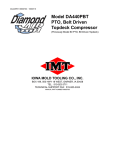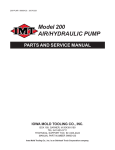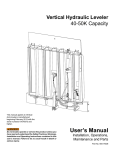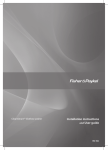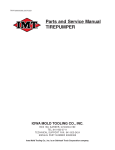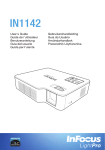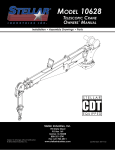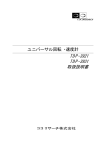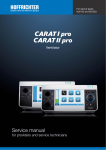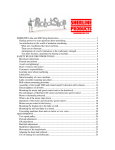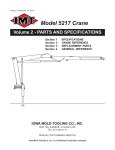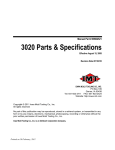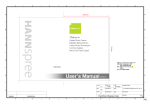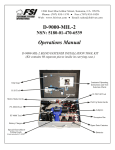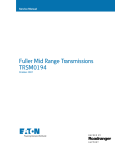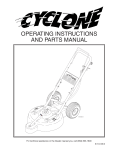Download Model CAS4110HU Hydraulic Driven Underdeck Compressor
Transcript
CAS4110HU: 99900783: 20110209 i Model CAS4110HU Hydraulic Driven Underdeck Compressor IOWA MOLD TOOLING CO., INC. BOX 189, 500 HWY 18 WEST, GARNER, IA 50438 TEL: 641-923-3711 TECHNICAL SUPPORT FAX: 641-923-2424 MANUAL PART NUMBER 99900783 Iowa Mold Tooling Co., Inc. is an Oshkosh Corporation company. CAS4110HU: 99900783: 19980224 ii PRECAUTIONS Read before operating your compressor! DANGER EXPLODING TANK WILL CAUSE DEATH, SERIOUS INJURY OR PROPERTY DAMAGE 71393886 ● Drain air tank after each use to prevent moisture build-up and corrosion which leads to tank failure. ● Assure that tank and compressor relief valves work properly, and are at correct pressure settings. ● DO NOT modify or repair air tank. ● NEVER drive vehicle with pressure in air tank. CAS4110HU: 99900783: 19980224 PARA iii TABLE OF CONTENTS TITLE PAGE Section 1. GENERAL INFORMATION 1-1. INTRODUCTION .................................................................................................... 1-1 1-2. COMPRESSOR SPECIFICATIONS ........................................................................ 1-1 1-3. ORDERING INFORMATION ................................................................................... 1-1 Section 2. INSTALLATION 2-1. GENERAL ............................................................................................................... 2-1 2-2. PTO AND PUMP INSTALLATION ........................................................................... 2-1 2-2-1. PTO INSTALLATION .............................................................................................. 2-1 2-2-2. DRIVELINE AND PUMP INSTALLATION ............................................................... 2-2 2-3. UNDERDECK COMPRESSOR INSTALLATION .................................................... 2-3 2-4. OIL COOLER (OPTIONAL) .................................................................................... 2-4 Section 3. OPERATION 3-1. INTRODUCTION .................................................................................................... 3-1 3-2. OPERATION ........................................................................................................... 3-1 3-3. SYSTEM SHUTDOWN ........................................................................................... 3-1 Section 4. PREVENTIVE MAINTENANCE 4-1. INTRODUCTION .................................................................................................... 4-1 4-2. LUBRICATION ........................................................................................................ 4-1 4-3. HYDRAULIC SYSTEM ........................................................................................... 4-1 4-3-1. HYDRAULIC FLUID SELECTION .......................................................................... 4-1 4-3-2. HYDRAULIC FLUID SPECIFICATIONS ................................................................. 4-1 4-3-3. HYDRAULIC FLUID DETERIORATION ................................................................. 4-1 4-3-4. HYDRAULIC SYSTEM PURGING ......................................................................... 4-2 4-3-5. FILTER ELEMENT REPLACEMENT ...................................................................... 4-2 4-4. PREVENTIVE MAINTENANCE CHECKLIST ........................................................ 4-3 Section 5. REPAIR 5-1. INTRODUCTION .................................................................................................... 5-1 5-2. HYDRAULIC SYSTEM COMPONENTS ................................................................ 5-1 5-3. DRIVE BELT ........................................................................................................... 5-1 Section 6. PARTS 6-1. GENERAL .............................................................................................................. 6-1 Section 7. REFERENCE LIST OF ILLUSTRATIONS FIG TITLE B-1. B-2. B-3. B-4. D-1. D-2. E-1. E-2. F-1. G-1. G-2. PTO INSTALLATION .............................................................................................. 2-2 DRIVELINE AND PUMP INSTALLATION ............................................................... 2-2 KILL SWITCH WIRING DIAGRAM ......................................................................... 2-3 OIL COOLER-GENERAL HYDRAULICS DIAGRAM .............................................. 2-4 HYDRAULIC FLUID SPECIFICATIONS ................................................................. 4-1 PREVENTIVE MAINTENANCE CHECKLIST ........................................................ 4-3 DRIVE BELT ADJUSTMENT .................................................................................. 5-1 HYDRAULIC SYSTEM TROUBLESHOOTING CHART ......................................... 5-2 CAS4110HU HYDRAULIC UNDERDECK COMPRESSOR (23000143) .............. 6-1 TORQUE DATA CHART ......................................................................................... 7-1 TIRE LOAD AND INFLATION PRESSURES .......................................................... 7-2 PAGE CAS4110HU: 99900783: 19980224 iv RECOMMENDED SPARE PARTS LIST 1 Year Supply CAS4110HU HYDRAULIC DRIVEN TOPDECK COMPRESSOR For Manual: 99900783 This spare parts list does not necessarily indicate that the items can be expected to fail in the course of a year. It is intended to provide the user with a stock of parts sufficient to keep the unit operating with minimal down-time waiting for parts. There may be parts failures not covered by this list. Parts not listed are considered as not being Critical or Normal Wear items during the first year of operations and you need to contact the distributor or manufacturer for availability. ASSEMBLY DESIGNATION 23000143.01.19970403 ITEM NO. PART NO. DESCRIPTION HYDRAULIC UNDERDECK COMPRESSOR 6 70029548 MOTOR/VALVE BLOCK 10 70058538 BELT-POWER V 11 89086120 OIL-30WT NON-DETERGENT 26 77041008 PRESSURE SWITCH 33 73054031 UNLOADER VALVE REF 70029548 MOTOR PART REF 73054740 RELIEF VALVE REF 77041495 COIL REF 73054962 CARTRIDGE & SOLENOID COMPRESSOR (R70)-70073084 REF REF REF REF REF REF REF 73054339 70073722 70141696 70073721 70073429 70048009 76391359 SAFETY VALVE LP INTAKE VALVE HP INTAKE VALVE LP EXHAUST VALVE HP EXHAUST VALVE AIR FILTER SEAL QTY CODE 1 1 1 1 1 1 1 1 1 W C P C C C C C C 1 1 1 1 1 1 1 W W W W W P W SHELF LIFE (MO) ORDER QTY CAS4110HU: 99900783: 20090409 1-1 SECTION 1. GENERAL INFORMATION 1-1. INTRODUCTION 1-2. COMPRESSOR SPECIFICATIONS This manual provides information on the installation, operation and repair of the IMT DA4110HU Hydraulic Under Deck Compressor. Three means are used throughout this manual to gain the attention of operating and service personnel. They are NOTES, CAUTIONS and WARNINGS and are defined as follows: NOTE A NOTE IS USED TO EITHER CONVEY ADDITIONAL INFORMATION OR TO PROVIDE FURTHER EMPHASIS FOR A PREVIOUS POINT. CAUTION A CAUTION IS USED WHEN THERE IS THE STRONG POSSIBILITY OF DAMAGE TO THE EQUIPMENT OR PREMATURE EQUIPMENT FAILURE. CAS44110HU Delivery at 175 psi Fluid capacity 104 cfm (2945 lpm) 47-62 gal (178- 235 l) Filter-Hydraulic Suction Filter-Hydraulic Return 100 mesh 10 microns Pressure Switch 175 psi off / 150 psi on (12 psi off/ 10 psi on) Comp. Pulley RPM Normal Op. Pressure 900 rpm (800 - 1000) 1850 psi (130 bar) Maximum Pressure GPM 2400 psi (165 bar) 28 gpm (106 lpm) Motor Pulley Dia. Compressor Pulley Dia. 10.75" (27 cm) 22.19" (56 cm) WARNING A WARNING IS USED WHEN THERE IS THE POTENTIAL FOR PERSONAL INJURY OR DEATH. Operate this equipment with respect and service it regularly. These two things can add up to a safer working environment and longer equipment life. 1-3. ORDERING INFORMATION When placing orders or requesting assistance, refer to the information below: TO BE COMPLETED BY DEALER CHASSIS INFORMATION TRANSMISSION MAKE: MODEL: PTO NUMBER: PTO %: COMPRESSOR AND HYDRAULIC PUMP INFORMATION COMPRESSOR MODEL: SERIAL NUMBER: PUMP MAKE: MODEL: RESERVOIR CAPACITY: ENGINE RPM: CAS4110HU:99900783:19950110 1-2 NOTES CAS4110HU:99900783:19950110 2-1 SECTION 2. INSTALLATION 2-1. GENERAL This section deals with the installation of the PTO and pump and the IMT hydraulic compressor. The instructions are intended as a guide to assist you with your particular installation. We can not cover every make, model and year of truck manufactured world-wide, so these instructions will provide only general information. Use this section as a guide only. 2-2. PTO AND PUMP INSTALLATION The pump may either be installed directly on the PTO or, as an optional method, it may be driven by a driveline. 2-2-1. PTO INSTALLATION Power take-off manufacturers provide specific installation instructions for their products. Those instructions should be followed when installing a PTO. Some trucks may require modification of the transmission cross-member to provide clearance and the exhaust pipe may need modification. Check with the PTO manufacturers representative for specific instructions regarding your particular make, model and year of vehicle. The following instructions are a guide in this application. 1. If the vehicle is new, drain the transmission oil into a clean container for reuse. If the vehicle is used, drain and dispose of the transmission oil. 2. Temporarily install the PTO with the proper gaskets and only two studs. Snug the PTO down and check the backlash for maximum allowance of 1/32" to 1/16". If the backlash is excessive, remove gaskets and check backlash again until it is corrected. 3. Remove the PTO and apply Permatex® to the gaskets. If the holes for the studs are tapped through the transmission housing, apply Permatex to the studs and tighten them down. Make certain that the studs do not interfere with the transmission gears. CAUTION AVOID CONTACT OF PERMATEX WITH AUTOMATIC TRANSMISSION FLUID. 4. Install the PTO and gaskets. Torque the nuts to 30 - 35 ft-lbs (4.14 - 4.84 kg-m) for a 6-bolt PTO and 45 - 50 ft-lbs (6.22 - 6.91 kg-m) for 8-bolt PTOs. Recheck the backlash. 5. Install the shifter cable to suit conditions. Always allow for a slight overshift on lever or knob to ensure the PTO is fully disengaged. CAUTION IT IS IMPORTANT THAT ROOM BE ALLOWED FOR FULL ENGAGEMENT OF THE PTO. MODIFY THE EXHAUST OR OTHER OBSTRUCTIONS AS NEEDED. CAUTION AVOID SHARP BENDS IN THE SHIFTER CABLE. ALL BENDS SHOULD HAVE AT LEAST A 6" RADIUS. TIGHTER BENDS WILL CAUSE DIFFICULT OPERATION OF THE SHIFTER KNOB. 6. Replace the transmission oil. If the PTO is located below the transmission oil level, an additional quantity of oil will be required. 7. Start the engine, engage the PTO and allow it to run for 5-10 minutes. Check for leaks, unusual noise and proper operation. 8. Retorque the mounting bolts. CAS4110HU:99900783:19990119 2-2 2-2-2. DRIVELINE AND PUMP INSTALLATION The pump may be driven as shown in Figure B-2 as an optional method to the one shown in Figure B-1. The following steps are a guide in this application. 1. Install the PTO (refer to Paragraph 2-2-1). 2. Loosely bolt the pump mounting bracket (A) to the adjustable bracket (B). 3. Bolt the adjustable bracket to the frame at a point that will not exceed 48" (122 cm) from the PTO and will not cause a joint angle greater than 8°. WARNING THE INSTALLER OF THE DRIVELINE MUST INSPECT THE FINAL POSITION OF THE DRIVELINE TO DETERMINE WHETHER ITS LOCATION PROVIDES SUFFICIENT PROTECTION TO AN OPERATOR, OR OTHER PERSONNEL, FROM HAZARDS ASSOCIATED WITH A ROTATING DRIVELINE. IF PROTECTION IS INSUFFICIENT, THE INSTALLATION OF A GUARD IS REQUIRED. IF YOU ARE UNSURE OF METHODS TO GUARD A ROTATING DRIVELINE, CALL IOWA MOLD TOOLING CO., INC. FOR INSTRUCTIONS. FAILURE TO DO SO MAY RESULT IN SERIOUS INJURY OR DEATH. 4. Check pump rotation and install pump, pump end yoke and PTO end yoke. 5. Size, cut and weld the driveline to the necessary length. Ensure driveline balance. Allow 1" (2.54 cm) extra for PTO end yoke. 6. Install driveline, lock set screws and lubricate Ujoints. 7. Ensure all mounting bolts are tight. FIGURE B-1. PTO INSTALLATION FIGURE B-2. DRIVELINE & PUMP INSTALLATION CAS4110HU:99900783:19950120 2-3. UNDERDECK COMPRESSOR INSTALLATION Due to variations, the instructions should be used as a guide only. 1. Position the compressor below the compressor compartment with the belt side to the rear of the compartment. 2. Lift the compressor base into position, so the base is flush with the bottom of the compartment. Be certain there is clearance within the compartment and no interference is present. Support the compressor in this position. 3. Using the base as a template, drill eight holes 17/32" diameter through the compartment. 4. Bolt the compressor base to the walls of the compartment using 1/2" grade 5 cap screws, flat washers and lock nuts. 5. Connect the hydraulic hose from the pump to the relief valve connected to the hydraulic drive motor on the compressor. See compressor assembly drawing. 2-3 8. Connect the air hoses per the compressor assembly drawing. 9. Install the engine speed control as shown and connect hoses from compressor to speed control. 10. Fill the oil reservoir and open the suction gate valve. Disconnect the pressure hose at the hydraulic pump. Engage the PTO and turn the vehicle engine with the starter until oil flows through the pressure side of the pump. Reconnect the pressure hose. Pull out the compressor switch and open the gate valve to the air receiver. Disengage the PTO and start the truck. Depress clutch and engage PTO. Release the clutch slowly. It may be necessary to warm the truck engine so that it will pull at idle RPM. Push in the compressor switch. This will close the control valve and start the compressor. Allow for warm-up time. Close the gate valve on the air receiver. This will activate the speed control. Adjust the engine speed control for proper operating RPM. Check for system leaks and proper operation. 11. Install compressor kill switch. See Figure B-1. 6. Connect the return line to the reservoir. See compressor assembly drawing. 7. Torque all mounting bolts per Torque Data Chart if the compressor is positioned properly. FIGURE B-3. KILL SWITCH WIRING DIAGRAM CAS4110HU:99900783:19950120 2-4 2-4. OIL COOLER (OPTIONAL) Oil coolers vary in their installation dependent on available space and other considerations. Install the oil cooler either in front of the carrier vehicle’s radiator or, as an alternative, in a protective structure which is cooled by an electric fan. Refer to Figure B-4 for general location within the hydraulic system. FIGURE B-4. OIL COOLER-GENERAL HYDRAULICS DIAGRAM CAS4110HU:99900783:19950719 3-1 SECTION 3. OPERATION 3-1. INTRODUCTION CAUTION This section deals with the proper methods of system operation and shutdown. These procedures should be followed to prevent damage and ensure efficient operation. 3-3. SYSTEM SHUTDOWN. 3-2. OPERATION The compressor has an operating time limit of approximately 3-hours depending upon ambient air temperature (outside air temperature), weather conditions and whether an oil cooler has been installed. CAUTION THE HYDRAULIC OIL TEMPERATURE MUST NOT BE ALLOWED TO EXCEED 190°F (88°C). IF THE OIL TEMPERATURE REACHES THIS LIMIT, THE SYSTEM MUST BE SHUT DOWN AND ALLOWED TO COOL. Oil coolers will extend the 3-hour limit. To start the compressor: 1. Ensure the PTO is disengaged, control valve is open (pull the compressor switch out) and the receiver drain cock is open. 2. Start the truck engine and allow it to idle until it reaches the proper operating temperature (refer to the Owners Manual). 3. Depress the clutch, engage the PTO and carefully release the clutch pedal. Allow the system to warm up for the time period specified in below. COMPRESSOR WARM-UP TIME AMBIENT AIR TEMPERATURE (°F) +40 OR ABOVE +20 TO +40 0 TO +20 -20 TO 0 -40 TO -20 BELOW -40 1000 RPM MAX. Operating this unit in excess of 1000 RPM, measured at the compressor flywheel, will void your warranty. Engine RPM may be different. IDLING TIME (WARM-UP) NONE 2 - 5 MINUTES 5 - 10 MINUTES 10-15 MINUTES 15-20 MINUTES 20 MINUTES MIN. 4. When starting the compressor, the RPMs will automatically increase due to low volume of air in the system. System shutdown is accomplished as follows: 1. Allow the compressor to build to maximum pressure and the truck engine will automatically idle down. 2. Place the compressor control valve in the open (off) position. 3. Depress the clutch pedal and disengage the PTO. 4. Open the receiver drain cock and discharge the air in the receiver. WARNING FEDERAL LAW PROHIBITS DRIVING THE CARRIER VEHICLE ON PUBLIC ROADS WITH THE RECEIVER FILLED WITH COMPRESSED AIR. ALWAYS DRAIN THE RECEIVER BEFORE MOVING THE VEHICLE. CAS4110HU:99900783:19950110 3-2 NOTES CAS4110HU 99900783:19950110 4-1 Section 4. PREVENTIVE MAINTENANCE 4-1. INTRODUCTION Proper maintenance on a regular schedule is essential to keep your unit operating efficiently. Proper maintenance procedures and required service intervals are outlined in this section. Personnel responsible for unit upkeep should become familiar with frequency and type of maintenance required and perform these tasks at recommended intervals. 4-2. LUBRICATION The only lubrication required is on the carrier vehicle and the compressor itself. Refer to the appropriate Owners Manual for information on the truck and compressor for the type and frequency of lubrication required. 4-3. HYDRAULIC SYSTEM 4-3-1. HYDRAULIC FLUID SELECTION Minimum viscosity specifications for hydraulic oil to be used in the hydraulic system are given in Figure D-1. Any major oil company can supply products which meet these requirements. Oils selected for use with this class of equipment, in addition to meeting viscosity requirements, should have the following additives: 1. Antifoam Inhibitors 2. Antioxidant Inhibitors 3. Rust Resistant Additives 4. Antiwear Additives 4-3-2. HYDRAULIC FLUID SPECIFICATIONS Figure D-1 states oil specifications for a full range of operating temperatures encountered in the temperate zones. Arctic conditions present special requirements which are not in the scope of the table and must be analyzed individually. Consult your oil supplier for the proper hydraulic fluids for working under these severe conditions. Electric reservoir heaters are available to improve conditions at extremely low temperatures. 4-3-3. HYDRAULIC FLUID DETERIORATION Contamination of the hydraulic fluid by solvents, water, dust or other abrasives will cause deterioration of the fluid. Sustained presence of the impurities will result in premature breakdown of antifoam, lubrication, anti-rust and viscosity properties. Introduction of water to the system and operation at high temperatures (above 180°F) will result in an increase in the oil oxidation rate. Oxidation produces varnish forming materials and sludge in the oil. Operating the system on a sustained basis with contaminated or broken down oil will increase wear and can significantly shorten the efficient service life of the unit. FIGURE D-1. HYDRAULIC FLUID SPECIFICATIONS CAS4110HU 99900783:19950110 Periodically, draw off a sample of the oil and check the oil for breakdown. To check oil quality: 1. Place the oil in a clean glass. 2. Smell the oil to detect a burnt or rancid odor. 3. Visually examine the oil for a dark or cloudy appearance. 4. Allow the sample to stand for several minutes. Inspect the sample for water which will settle to the bottom of the glass if present. Water can result from a system leak or condensation due to temperature extremes. When any of these conditions is observed, the system should be purged and filled with new oil. In addition, the oil should be changed in the reservoir and complete system: 1. After every 800 hours of operation or every six months, whichever occurs first. 2. After pump or other major hydraulic component failure, drain the hoses. 4-3-4. HYDRAULIC SYSTEM PURGING Purging the hydraulic system requires a new oil supply sufficient to completely fill the reservoir, hoses, filters, valves, etc., and an extra allowance for loss during this procedure. To reduce oil loss, operate the engine at a low speed (idle). When purging, new oil is supplied to the pump suction line via the reservoir, and the old oil is discharged through the reservoir return line. Two operators will be required; one to operate the compressor and the other to regulate pump flow (engine speed). Purging is accomplished as follows: 1. Drain the hydraulic reservoir and disconnect the suction hose to the pump. Drain the hose and reassemble. Change the suction filter cartridge (Paragraph 4-3-5). NOTE THE METHOD OF WASTE DISPOSAL IS LEFT TO THE DISCRETION OF SERVICE PERSONNEL. 4-2 2. Disconnect the reservoir return line at the reservoir and direct the discharge into a sump or waste container. Plug the return line port on the reservoir and fill the reservoir with clean oil (refer to Paragraph 4-3-1). NOTE BE THOROUGHLY FAMILIAR WITH THE FOLLOWING STEPS AND PREPARED TO PERFORM THEM IN AN UNINTERRUPTED SEQUENCE. IF THIS IS NOT DONE, EXCESSIVE OIL WASTE WILL OCCUR. CAUTION DO NOT ALLOW THE RESERVOIR LEVEL TO DROP BELOW 1/3 CAPACITY DURING THIS OPERATION. 3. Start the engine and engage the PTO. Slowly release the clutch. Activate the control valve so that the fluid passes through the motor. Allow fluid to discharge for about 15 seconds. Kill the engine. 4. Reconnect the return line to the reservoir port and change the return line filter. All components of the system are now purged. 5. Check the reservoir oil level and add oil as necessary. 4-3-5. FILTER ELEMENT REPLACEMENT To avoid residue accumulation in the reservoir and to protect the hydraulic components (valves, pumps,motors, etc.), the filters must be serviced on a regular basis. They must be changed after the initial 50-hours of new unit operation and every 200-hours thereafter.To change filter elements: 1. Shut the gate valve and remove the filter element. 2. Install the new filter ensuring proper rubber seal seating and tighten as much as possible using both hands. 3. Open the gate valve and check for leaks. CAUTION PUMP FAILURE CAN RESULT IF THE SHUTOFF VALVE IS LEFT CLOSED. CAS4110HU 99900783: 19950110 4-3 4-4. PREVENTIVE MAINTENANCE CHECKLIST The checklist (Figure D-2) is designed to assist you in keeping your unit in efficient operating condition. Items in this section apply to the unit only. The carrier vehicle should also be inspected regularly (refer to the carrier vehicles service manual). FIGURE D-2. PREVENTIVE MAINTENANCE CHECKLIST CAS4110HU 99900783: 19950110 4-4 CAS4110HU:99900783:19950110 5-1 SECTION 5. REPAIR 5-1. INTRODUCTION 5-3. DRIVE BELT This section deals with the disassembly and repair of the components as well as troubleshooting information. To adjust the drive belt tension and alignment: 5-2. HYDRAULIC SYSTEM COMPONENTS Disassembly and repair of components in the hydraulic system requires special consideration for proper functioning and service life of the unit. These steps are to be followed whenever a hydraulic component is removed from the system. 1. ALWAYS relieve internal hydraulic pressure before proceeding with a repair, carefully loosen a fitting and allow the pressure to bleed off. 1. Loosen the four bolts securing the motor mounting bracket to the base plate. 2. Turn the drawbolt in a clockwise direction to tighten the belt until there is 1/4" - 1/2" play at the center of the belt between the pulleys. 3. Adjust the alignment drawbolt until the motor pulley is square with the compressor. Use a straightedge across the compressor pulley (Figure E3) and check the gap between the motor pulley and the straight edge. The gap (1-3/4") on the compressor side of the motor pulley should be the same as on the far side of the pulley. 2. NEVER allow foreign matter (dirt, water, metal particles, etc.) to enter the system through the open connections. Cap or plug any openings. If dirt does get in, a filter change is required after 50 hours of operation. 3. ALWAYS check for high pressure leaks after completing a repair. A high pressure leak is hazardous and must be repaired. FIGURE E-1. DRIVE BELT ADJUSTMENT CAS4110HU:9900783: 19950110 5-2 FIGURE E-2. HYDRAULIC SYSTEM TROUBLESHOOTING CHART CAS4110HU: 23000143.01.REV E 20110209 6-1 SECTION 6. PARTS 6-1. GENERAL This section contains the exploded parts drawings with accompanying parts lists for associated assemblies. These drawings are intended to be used in conjunction with the instructions found elsewhere in this manual. For information pertaining to the compressor, refer to its specific manual. See Section 7 for reference data which may be useful in the repair and operation of your compressor. (PART OF ORIGINAL COMPRESSOR) TO SPEED CONTROL (IDLE PRESSURE) (PART OF 26 ORIGINAL 33 COMPRESSOR) PILOT UNLOADER 29 19 18 28 21 20 25 20 22 23 PART OF ORIGINAL COMPRESSOR ITEM PART NO. DESCRIPTION 1. 2. 3. 4. 5. 6. 7. 8. 9. 10. 11. 12. 13. 14. 15. 16. 17. 18. 19. 20. 21. 22. BASE 1 BRACKET-HYD MOTOR MTG 1 TIGHTENER BOLT 8" 2 TIGHTENER BAR 1 COMPRESSOR R70 1 MOTOR/VALVE BLOCK 1 KEY-OFFSET .25X.31X.39X1.50 1 PULLEY (WAS 71056020) 1 BUSHING-SPL TAPER (WAS 70056453) 1 BELT-POWER V 9093 3096 1 OIL-30WT NON-DETERGENT 1.5GAL IDENT PLACARD (NOT SHOWN) 1 CAP SCR 1/2-13X2 HHGR5 4 NUT 1/2-13 LOCK 12 WASHER 1/2 WRT 6 CAP SCR 1/2-13X1-3/4 HHGR5 4 CAP SCR 1/2-13X2-3/4 HHGR5 2 MUFFLER CLAMP 1-3/4 1 PIPE NIPPLE 1-1/4NPT X 5 1 ELBOW 1-1/4NPT 90° 2 PIPE NIPPLE 1-1/4NPT X 3 1 STREET ELBOW 3/8NPT 90° 1 52702376 52070869 52706302 60104598 70073084 70029548 60118716 70056664 70056665 70580206 89086120 70029117 72060095 72062080 72063005 72060094 72060986 72066503 72532840 72053327 72053213 72053283 QTY TO AIR TANK 28 24 32 27 ITEM PART NO. DESCRIPTION 22. 23. 24. 25. 26. 27. 28. 29. 30. 31. 32. 33. 72053283 72053049 72053013 72532013 77041008 72532552 72532974 72053651 72066340 72533032 70048069 73054031 34. 35. 36. 37. 38. 39. 40. 41. 42. 72053767 72532949 72053589 99900783 72532145 72053013 72532834 72053751 72053211 STREET ELBOW 3/8NPT 90° PIPE NIPPLE 3/8NPT X CLOSE NIPPLE-PIPE BLK .25 X CLOSE STREET TEE 1/4NPT BRASS PRESSURE SWITCH HOSE FITTING 1/4-1/4 STREET ELB 1/4NPT 90° SHORT ADAPTER 1-1/4NPT SWVL POP RIVET ELBOW-MJIC/45/FJIC 12 12 AIR FILTER UNLOADER VALVE (155-175) (PART OF COMPRESSOR) ELBOW-MSTR/90/MJIC 12 12 ADAPTER MSTR/FSTR 20 12 STREET ELBOW 1/8NPT 90° MANUAL PLUG 1-5/8STR HH STL NIPPLE-PIPE BLK .25 X CLOSE NIPPLE-BEAD 90 DEG 1 MPT 1.25 ADAPTER MSTR/FPT 16 1 NIPPLE-PIPE BLK 1.25 X CLOSE QTY 1 1 1 3 1 2 2 1 2 1 1 1REF 1 1 1 1 1 1 1 1 1 FIGURE F-1. CAS4110HU HYDRAULIC UNDERDECK COMPRESSOR (23000143-1) CAS4110HU: 23000143.02.20110209 R70 COMPRESSOR (REF) 5 6-2 8 13 13 16 38 6 9 2 16 9 7 10 17 RETURN PRESSURE 14 15 14 1 14 15 3 15 3 4 14 FIGURE F-1A. CAS4110HU HYDRAULIC UNDERDECK COMPRESSOR (23000143-2) CAS4110HU:99900783: 19950110 7-1 SECTION 7. REFERENCE When using the torque data in the charts above, the following rules should be observed. 1. Bolt manufacturer’s particular specifications should be consulted when provided. 2. Flat washers of equal strength must be used. 3. All torque measurements are given in foot-pounds. To convert to inch-pounds, multiply by 12. 4. Torque values specified are for bolts with residual oils or no special lubricants applied. If special lubricants of high stress ability, such as Never-Seez compound graphite and oil, molybdenum disulphite, collodial copper or white lead are applied, multiply the torque values in the charts by the factor .90. The use of Loctite does not affect the torque values listed above. 5. Torque values for socket-head capscrews are the same as for Grade 8 capscrews. FIGURE G-1. TORQUE DATA CHART CAS4110HU:99900783: 19950110 7-2 FIGURE G-2. TIRE LOAD AND INFLATION PRESSURES CAS4110HU:99900783: 7-3 CAS4110HU:99900783: 7-4 This parts manual is provided to the user to assist in servicing the equipment. It is the propertyof Iowa Mold Tooling Co., Inc and, as such, may not be reproduced either whole or in part,whether by chemical, electrostatic, mechanical or photographic means without the expressedwritten permission of an officer of Iowa Mold Tooling Co., Inc. One manual is provided with each piece of new equipment and additional manuals may be obtained at a nominal price. IOWA MOLD TOOLING CO., INC. BOX 189, GARNER, IA 50438-0189 TEL: 641-923-3711 TECHNICAL SUPPORT FAX: 641-923-2424
























